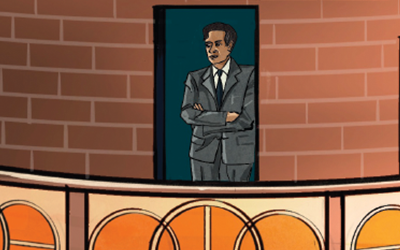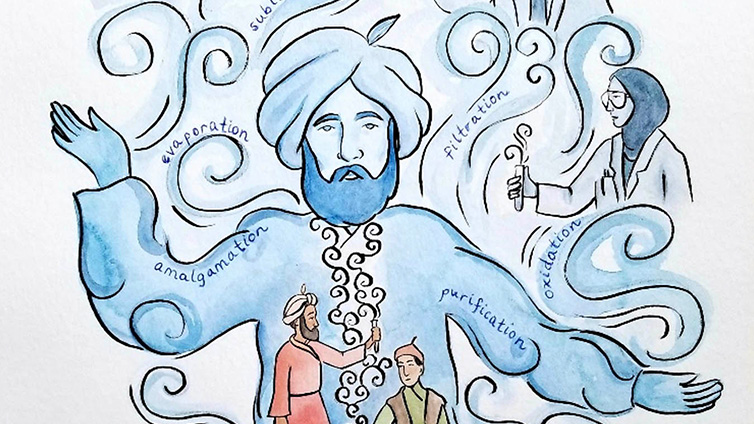Stars Die
Driving Question: Why is the death of stars important?
The birth of stars created new sources of light, energy, and complexity in the Universe. But they can’t live forever, right? New chemical elements exploded from dying stars, often in the form of huge supernovas that scattered these elements throughout the Universe.
Learning Objectives:
- Describe the creation of new elements.
- Apply the historical thinking skill of causation to investigate the birth and death of stars.
- Explain how the death of stars increased the Universe’s complexity.
Vocab Terms:
- complexity
- element
- gravity
- nuclear fusion
- star
- supernova
- temperature
Opener: Stars Die
To teach this lesson step, refer to page 2 of the Lesson 2.4 Teaching Guide.
Don’t forget to consider how to adapt, modify, or differentiate this lesson for your students—use this guide to get you started.
What do blueberry muffins and cell phones have in common? Hint: It has something to do with dying stars.
New Chemical Elements
To teach this lesson step, refer to page 3 of the Lesson 2.4 Teaching Guide.
What do you want your student to learn about new chemical elements? Check out what these teachers had to say about this in the OER Project Teacher Community.
Threshold by Threshold, the Universe grows more complex. See what effects all those supernovas had on their surroundings.
The Death of Stars
To teach this lesson step, refer to page 4 of the Lesson 2.4 Teaching Guide.
Learn more about OER Project’s approach to teaching causation on this page.
Aging and dying stars generate extremely hot temperatures, hot enough to create entirely new elements. Learn what star stuff gave us as you think more about cause and effect.
What Did Star Stuff Give Us?
Closer: Stars Die
To teach this lesson step, refer to page 5 of the Lesson 2.4 Teaching Guide.
Remember that Closers are a great opportunity to informally assess student understanding. Read more about that in the OER Project Assessment Guide.
Let’s bring the focus back to you. How does thinking about the Big History story of stars and elements make you feel? Where do you fit in?
Chemical Reactions
To teach this lesson step, refer to page 5 of the Lesson 2.4 Teaching Guide.
In comics, chemical elements often transform normal people into superheroes. But what if those chemical elements themselves are the real superheroes?
The Evolving Star
To teach this lesson step, refer to page 6 of the Lesson 2.4 Teaching Guide.
It wasn’t until relatively recently that we learned more about how stars die, and what causes it. We have this Indian physicist to thank for a major breakthrough.
-
Guiding Questions
-
Before you read
Preview the questions below, and then skim the comic, paying attention to things like prominent colors, shapes, and types of text and fonts. How do you know where to start and in which direction to read? What’s in the gutters (the space between panels)? Who or what is the focus of the comic?
While you read
Look for answers to these questions:
- Looking at just the images, what do you think is the theme of this comic?
- What issues did Subrahmanyan Chandrasekhar face when he presented his calculations about the death of stars?
- What was Subrahmanyan Chandrasekhar’s experience at the University of Chicago?
- How has the artist designed the images in this comic to help you know in which order to read the text?
After you read
Respond to this question: How did Chandrasekhar’s theory become accepted?
Pure Metal
To teach this lesson step, refer to page 7 of the Lesson 2.4 Teaching Guide.
Modern chemistry provides many of the technologies and comforts we enjoy today. But it didn’t come from nowhere! Learn how the science evolved over centuries of experimentation.
-
Guiding Questions
-
Before you read
Preview the questions below, and then skim the article. Be sure to look at the section headings and any images.
While you read
Look for answers to these questions:
- What is the science of chemistry?
- How did humans work with chemical changes before the modern science of chemistry began?
- What contributions did Jābir Ibn Hayyān make?
- What is the debate about the identity of Jābir Ibn Hayyān?
- Why was Jābir Ibn Hayyān significant?
After you read
Respond to the following questions:
- The author of this article doesn’t describe Jābir Ibn Hayyān as a scientist, but he does suggest that Ibn Hayyān used many strategies and techniques that scientists would use. Why do you think the author chose not to call him a scientist?
- Why does it matter whom we describe as a scientist?















